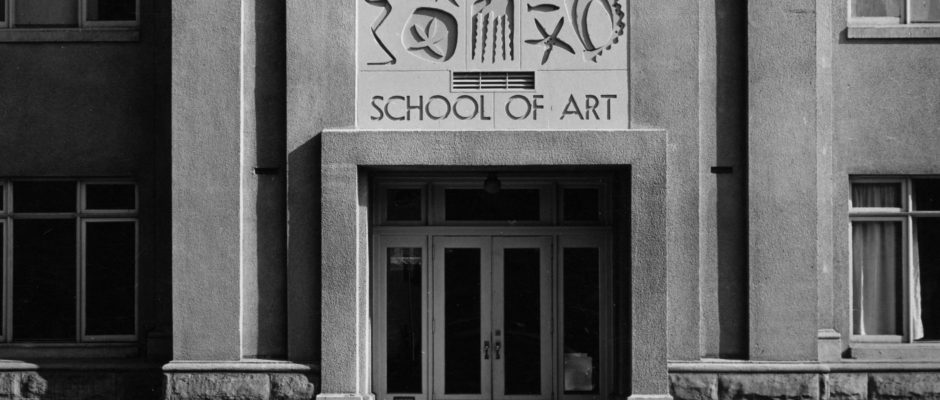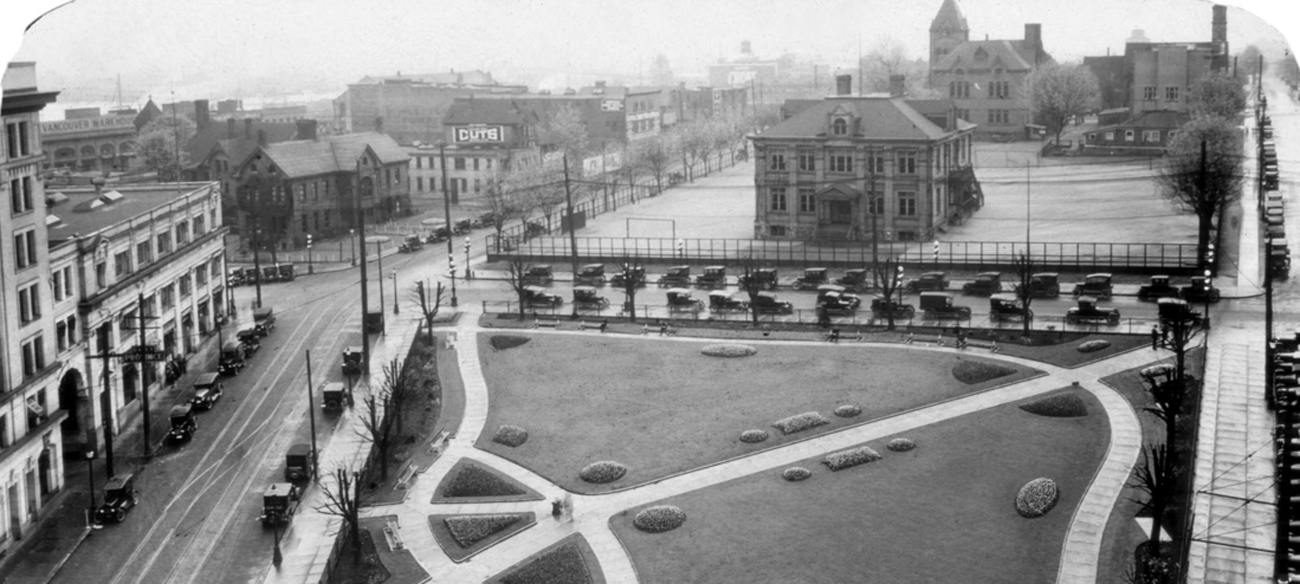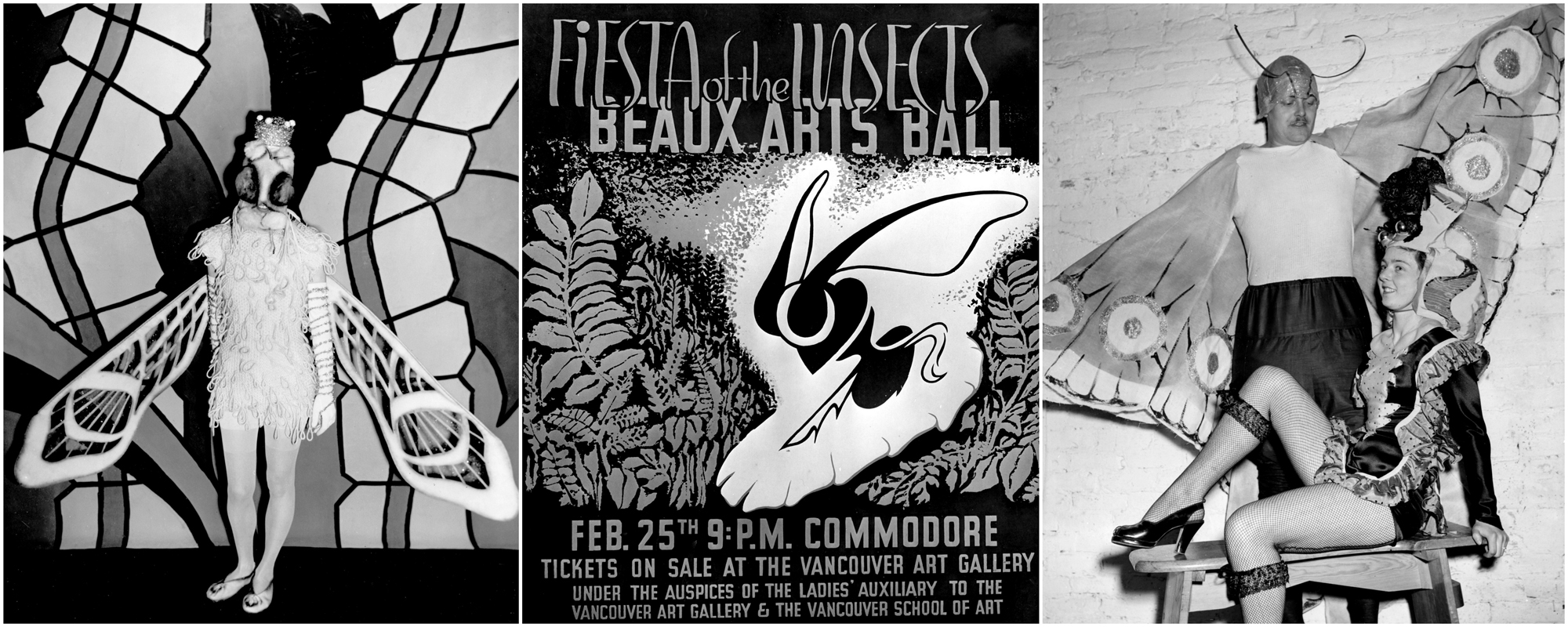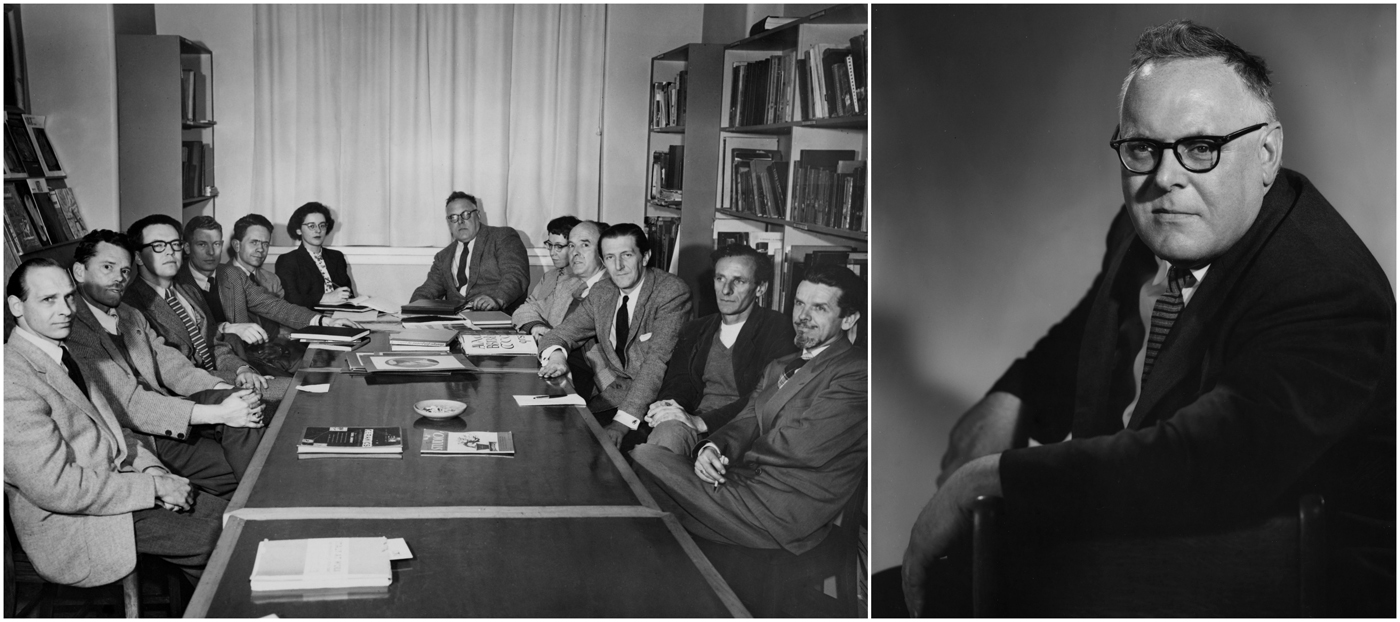The Vancouver School of Art – A Brief History

Looking south from Victory Square towards Block 37. During 1925 – 1980, the Vancouver School of Art occupied several different sites here.
Timeline:
1925: The Vancouver School of Decorative and Applied Arts opens on the top floor of the Vancouver School Board (VSB) building at 590 Hamilton Street.
1926: Charles Hepburn Scott is appointed Director of the school.
1933: The name of the school is changed to the Vancouver School of Art (VSA).
1936: The school moves to the nearby former Vancouver High School building at Cambie and Dunsmuir streets.
1952: The Vancouver School of Art returns to the building at 590 Hamilton Street, now renovated, following the move of the Vancouver School Board to new headquarters at 1595 West Broadway. Fred Amess, a graduate of the Vancouver School of Art is appointed Director of the school.
1963: Following the expansion of the Vancouver Vocational Institute (VVI), which occupies the same block as the Vancouver School of Art, the VSA moves to quarters within the new wing of the Vancouver Vocational Institute.
1965: The Vancouver School of Art becomes a division of the new Vancouver Community College (VCC). The Vancouver Vocational Institute, the Vancouver School Board’s Night School Program, and the King Edward Senior Matriculation Programs form the VCC’s other components.
1973: End of an era: the Vancouver School Board ends its role as administrator for the VCC.
1978: A BC Government Order-in Council establishes the Vancouver Community College as a fully independent body. The Vancouver School of Art again becomes an independent institution. Its name is changed to the Emily Carr College of Art and Design.
1980: The Emily Carr College of Art and Design moves to 1399 Johnston Street on Granville Island.
2008: The school is renamed the Emily Carr University of Art and Design to reflect its new status as a university with the authority to issue graduate degrees.
2017 The Emily Carr University of Art and Design relocates to a new campus at 520 East 1st Avenue just off Great Northern Way.
The Era of Charles Hepburn Scott (1926 – 1952)
TOP: Charles H. Scott in 1926, with other colleagues from the Vancouver School of Art ; BOTTOM: in 1951, a year before his retirement.
Charles Hepburn Scott, the Director of the Vancouver School of Art from 1926 – 1952, had a remarkable career. He was born in tiny hamlet of Newmilns, Scotland in 1886. In 1909, he obtained a Diploma from the Glasgow School of Art.
After immigrating to Canada, he served as Art Supervisor for the Calgary Board of Education from 1912 to 1914. Later in 1914, he won appointment as Art Supervisor for the Vancouver School District. In 1915 he took leave from this position to serve with the Canadian army in Europe during World War One. He was wounded in action.
In 1918, he returned to his job as Art Supervisor, a position he held until 1925. He also became involved in the B.C. Society of Fine Arts (Life Member, President 1920 – 1922) and the Organizing Committee of the B.C. Art League. In 1924, he co-authored a textbook Drawing and Design – A teacher’s Manual which was authorized by the BC Department of Education.
Throughout his life, he remained active as an artist. He produced an enormous number of oil paintings, drawings in pencil and pen and ink, etchings, and water colors, which were exhibited widely in many different venues.
…..
In 1940, Charles Hepburn Scott somehow found the time to write a history of the Vancouver School of Art for the book THE FIRST FIFTY YEARS Vancouver High Schools, published by the Vancouver School Board (pp 119 – 122):
In the early nineteen-twenties a band of art enthusiasts, citizens of Vancouver and other parts of the province, formed themselves into a society named “The B. C. Art League”. This League had two objects in view: the organization of an art school, and the founding of an art gallery in Vancouver. The League lived to see both objects realized, although in neither case did they take the form originally envisaged. The establishment of the art school owed much to the purposeful activity of the late John Radford, architect and painter. Mr. Radford may rightly be considered the father of the Vancouver School of Art.
The League’s desire was that the school should be under the control of an autonomous board composed of representatives elected from public bodies, and financed, in part, by a yearly grant from the Provincial Government. The latter, however, refused to aid financially, and referred the League to the Vancouver School Board.
After several meetings between the School Board and the League the ‘Board agreed to the opening of “The Vancouver School of Decorative and Applied Arts” as an integral part of the city school system. The purpose of the school, arrived at during the joint meetings of the Board and the League, was briefly stated as the “giving of carefully planned courses of training for workers in the graphic and applied arts”. The utilitarian aspect of the training was stressed from the beginning, in the belief that many trades and industries in Vancouver and British Columbia stood in need of trained artist workers.
The school was to be financed, in part, by monies derived from student fees (then fixed at $50.00 per annum) and the usual Provincial Government grant towards teachers’ salaries. The Vancouver School Board was to be responsible for the remainder. The minimum entrance age for students was to be sixteen years.
The curriculum was planned for a lower and a middle school, with all students taking the subjects offered in the lower school before proceeding to the middle. A higher school was something for the future. Subjects of the lower school course were as follows: Still-Life Drawing; Perspective; Geometrical Drawing; Lettering; Design; Clay Modelling; Figure Drawing; and Lectures on Art Appreciation. These subjects offered the students an experience sufficiently broad to form a basis for specialization in Drawing and Painting, Commercial Art, Design, Modelling, and Costume Design.
The School Board appointed Mr. G. Thornton Sharp, Architect, as director and, at the same time, called upon Mr. Charles H. Scott, Supervisor of Art in the city schools, at that time on leave of absence in Europe, to return and assume the duties of principal. Premises were found for the school on the top floor of the School Board Office building at 590 Hamilton Street, and here, in September, 1925, some forty enthusiastic students bore witness to the fact that the seed planted and nurtured by the B. C. Art League had come into bud.
In the spring of 1926, Mr. Sharp, who had accepted the position of director only in order to get the school under way, resigned. The Board called upon Mr. Scott to take over the executive duties of director.
The experiences of that first year, and the expectation of a larger student enrolment, made it patent to Mr. Scott that the future of the school was bound up in the securing of an adequate and permanent staff. By the session 1927-28, the staff included one instructor from Toronto, one from Edinburgh, and one from Glasgow.
Vancouver School of Decorative Arts (1928) Photo Credit: City of Vancouver Archives
The Day School enrolment grew until, by 1929, it had reached a more or less static point of one hundred. In that year, fees, raised previously to sixty dollars per annum, were increased to one hundred dollars per annum. The school offered a four-year Day Course to students able to take complete art training, and evening courses to students who were working during the day) Afternoon classes were organized for teachers, and Saturday morning classes for talented school children seeking further training. Additional rooms were obtained in the old Vancouver High School, situated immediately behind the School Board Offices.
In June, 1929, the school held its first graduating exercises. Eleven students qualified: Mr. Fred Amess, Miss Ada Currie, Miss Lilias Farley, Miss Frances Gatewood, Miss Irene Hoffar, Miss Phyllis Kirkpatrick, Miss Beatrice Lennie, Miss Marjorie Lyne, Miss Vera Weatherbie, Miss Margaret Williams and Mr. Yitkon Ho. The diploma granted to these graduates carried the seal of the Provincial Department of Education.
The school was functioning as a fully-organized and well-equipped art institution, capable of giving a training equal to that of any art school in Canada. The quality of the students’ work, when displayed in the East, caused favorable comment, and the many visitors from various parts of the Dominion and from overseas were warm in their praise of the school’s accomplishments. All things pointed to a steady growth when, suddenly, in 1933, municipal retrenchment cut deeply into School Board estimates, and many school services were reduced or dispensed with entirely.
Vancouver School of Art (1930) Photo Credit: City of Vancouver Archives
The work of the Art School would have been discontinued had it not been for Mr. Scott, who suggested that the school would be willing to attempt to bridge the period of financial difficulty by operating on the fees received, together with a small grant by the Provincial Department of Education. Such a course meant drastic salary reduction for all members of the staff, including the Director. Those few members of the staff who found the reductions offered by the Board unacceptable, resigned.
The session 1933-34 became a second beginning for the school. The staff, consisting of Mr. Scott and Miss Melvin, as full-time instructors, was augmented by part-time teachers and a few graduates of outstanding ability. The curriculum was altered somewhat, and the institution’s name was changed from the cumbersome “Vancouver School of Decorative and Applied Arts” to the more acceptable “Vancouver School of Art”.
The years that immediately followed were anxious ones, but backed by a loyal and capable staff, and enthusiastically supported by Mr. MacCorkindale, Superintendent of Vancouver Schools, the Director carried on the work of the institution with remarkable success.
By 1935 graduates of the school were many. These, together with the larger number of students who had studied for one, two, or three years, were now at work in various trades or professions; and many were contributing to exhibitions in the Art Gallery here, and elsewhere. The staff, by exhibitions of work in the East and abroad, by lecture engagements, and writings, and by participation in Art Gallery activities, did its part in helping to create an art consciousness in the city and province. The institution was beginning to have a pervasive influence on the life of the city.
The school, by 1936, had outgrown its accommodation. It was therefore arranged that the school should give up its quarters in the School Board Office building in return for the use of all the rooms of the old high school building. There, considerable renovation and decoration was effected, and in September, 1936, the school entered upon a new year in suitable and spacious quarters. Shortly after, the beautification of the school grounds gave to the surrounding area a pleasing view of lawn and garden.
The Department of Education, in 1937, requested that a Summer School be organized by the School of Art for the training of teachers for Elementary and Junior High School Art Certification. With the addition of this new course the institution consisted of a Day School, an Evening School, a Saturday Junior School, and a Summer School. Its total annual enrolment was now between four and five hundred students.
The extra-curricular activities of the school during its sixteen years of existence have included Summer Sketch Camps for students at Savary Island and elsewhere, Beaux-Arts Costume Balls, Christmas Nativity Plays, the production of an artistic School Annual, and participation in such special functions as “Cavalcade”, presented by the Public Schools of Vancouver on the occasion of the city’s Golden Jubilee.
The Vancouver School of Art, to the present, has brought new vision to thousands of art students. In the belief that its graduates will, more and more, leaven the cultural, industrial and social life of the province, the institution faces the future with enthusiasm.
BUILDINGS OCCUPIED BY THE VANCOUVER SCHOOL OF ART
PHOTO GALLERY
1. The top floor of the original 3-storey Vancouver School Board building, just visible at top right (1925 – 1937).
2. The former Vancouver High School building (1937 – 1952).
Charles H, Scott believed that the Vancouver School of Art should reach beyond the narrow confines of Block 37 into the community. Perhaps the most famous of these endeavors were the annual Beaux Art Balls held at the Commodore Ballroom on Granville Street. Each year a different theme was chosen. Student and staff, and guests would create their own costumes and help prepare backdrops on particular themes. The following photos are from Beaux Arts Balls held in the late 1940s.
Fiesta of the Insects (1949): pictured at top right, Mrs. H.N MacCorkindale; at bottom right, Mrs. C.A. Scott
4. The ‘new’ building (1952 – 1963), the former home of the Vancouver School Board.
1951: The old Vancouver School Board building under renovation as the new home of the Vancouver School of Art.
1952: Charles H. Scott being honoured at the official opening of the new Vancouver School of Art building.
1952: Fred Amess, the new Director of the Vancouver School of Art, and members of the teaching staff.
The new wing of the Vancouver Vocational Institute building, the home of the Vancouver School of Art from 1963 – 1980.
The following excerpt from a story by Aileen Campbell, published in the Province newspaper on Friday, August 01, 1975, features an interview with Robin Mayor, the third director of the Vancouver School of Art. Mayor sets out the argument for the creation of an independent art school in a separate building. This came to pass in 1978 with the designation of the school as a provincial institute, and its renaming as the Emily Carr School of Art. In 1980, the Emily Carr School of Art moved to a new campus on Granville Island in Vancouver’s False Creek.
ART SCHOOL SEEKS BIRTHDAY PRESENTS
By Aileen Campbell
The Vancouver School of Art is 50 years old in September and it would like a couple of things for its birthday — independence and a new home of its own.
It began life as the School of Decorative and Applied Arts in 1925 on the top floor of the old school board building at 590 Hamilton — realization of a goal of the long-defunct B.C. Art League.
It celebrates its 50th birthday short of another goal of long ago — independence, from either the school board or, as now is the case, the Vancouver College Council.
However, Robin Mayor, 37-year-old English-born director, third in the school’s history, believes independence day is near.
The Marsh report on Lower Mainland regional colleges recommended this year that the school of art be reconstituted as the B.C. Art Institute with a province-wide constituency.
And it’s not a moment too soon in Mayor’s view. “The Art League was on the right track in the beginning,” he said.
The league, a group of art enthusiasts and citizens in all parts of the province, wanted the school under an autonomous board, with representatives elected from public bodies and financed in part by a yearly grant from the provincial government.
The government refused, and referred the league to Vancouver school board. The art school became an integral part of the city’s school system.
However, Mayor, a graduate of St. Martin’s ‘School of Art in London and director of Bradley University School of Arts in Peoria, Ill., before his appointment here in 1972, considers the art school a provincial resource.
“Art is a very functional aspect of society.” he said in an interview.
It’s not “a frill around the edge” nor is the artist -a strange little bump” on society’s epidermis, Mayor added with vigor.
“I don’t believe art can be considered a cosmetic. It is an indigenous part of the life of society—utilitarian, functional, humanizing. The artist no longer exists in isolation.”
He also doesn’t come to art school over the family’s protestations, as was often the case 50 years ago, said Mayor.
Now there’s one in every family, almost.
Being a part of the Vancouver College set-up inhibits the school’s effectiveness in relation to the province, according to Mayor, and he terms it “philosophically, organizationally, and structurally inappropriate.
“Under the VCC, the art school is being absorbed into a monolithic structure that is not only rigid and cumbersome, but worse, that is ignorant of the principles, realities and particular nature of art education and thus not committed to it. Art school and the community college are philosophically divergent in critical ways.”
Development of an artist or designer is primarily perceptual and only secondarily the learning of skills, he said.
Attitude is more important than curriculum, he said, flexibility and openness more important than efficiency and space and people more important than equipment and parking. Mayor wants to develop students who can give themselves orders and then carry them out…





























